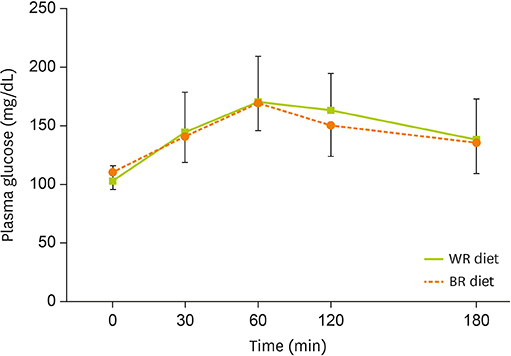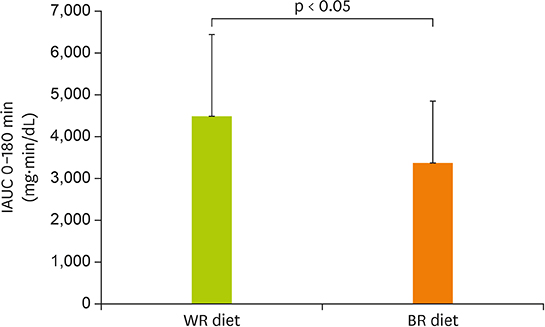Clin Nutr Res.
2020 Jan;9(1):43-51. 10.7762/cnr.2020.9.1.43.
Effect of High β-glucan Barley on Postprandial Blood Glucose and Insulin Levels in Type 2 Diabetic Patients
- Affiliations
-
- 1Division of Diabetes, Metabolism, and Endocrinology, Department of Medicine, Toho University Graduate School of Medicine, Tokyo 143-8541, Japan.
- 2Department of Diabetes and Endocrinology, Department of Medicine, Saiseikai Yokohamashi Tobu Hospital, Kanagawa 230-0012, Japan. mariko-h@wb3.so-net.ne.jp
- 3Nutrition Support Team, Saiseikai Yokohamashi Tobu Hospital, Kanagawa 230-0012, Japan.
- 4Department of Food Science, Faculty of Home Economics, Otsuma Women's University, Tokyo 102-8357, Japan.
- KMID: 2468663
- DOI: http://doi.org/10.7762/cnr.2020.9.1.43
Abstract
- The aim of our study was to investigate whether high β-glucan-containing barley (7.2 g per 100 g) improves postprandial plasma glucose levels and suppresses postprandial insulin levels during a meal tolerance test in type 2 diabetic patients. A meal tolerance test (500 kcal) was conducted using two types of test meals: a test meal with white rice (WR) alone (WR diet) and a test meal with WR mixed with 50% barley (BR diet) as staple food. The side dish was the same in the both meals. The changes in plasma glucose and serum C-peptide immunoreactivity (CPR) levels for 180 minutes after ingestion of the test meals were compared. Ten patients with type 2 diabetes (age 52.5 ± 15.1 years, and 7 males and 3 females) were included in this study. The mean HbA1c level and body mass index were 8.8 ± 1.4%, and 29.7 ± 4.5 kg/m², respectively. Plasma glucose levels after ingestion of the WR diet or BR diet peaked at 60 minutes, which showed no significant differences between the two types of test meals. However, the incremental area under the curve (IAUC) of plasma glucose levels after ingestion of BR diet was significantly lower than that of WR diet. The serum CPR levels at 180 min and their IAUC over 180 minutes after ingestion of BR diet were significantly lower than those of WR diet. Conclusion: Increase in postprandial plasma glucose and insulin levels was suppressed by mixing high-β-glucan barley with WR in type 2 diabetic patients.
MeSH Terms
Figure
Reference
-
1. International Diabetes Federation. IDF diabetes atlas-8th edition. 2019. cited 2019 June 15. Available from https://www.diabetesatlas.org.2. Mukai N, Doi Y, Ninomiya T, Hirakawa Y, Nagata M, Yoshida D, Hata J, Fukuhara M, Nakamura U, Kitazono T, Kiyohara Y. Trends in the prevalence of type 2 diabetes and prediabetes in community-dwelling Japanese subjects: The Hisayama Study. J Diabetes Investig. 2014; 5:162–169.
Article3. DeFronzo RA, Ferrannini E. Insulin resistance. A multifaceted syndrome responsible for NIDDM, obesity, hypertension, dyslipidemia, and atherosclerotic cardiovascular disease. Diabetes Care. 1991; 14:173–194.
Article4. Katakami N. Mechanism of development of atherosclerosis and cardiovascular disease in diabetes mellitus. J Atheroscler Thromb. 2018; 25:27–39.
Article5. Kato M, Noda M, Mizoue T, Goto A, Takahashi Y, Matsushita Y, Nanri A, Iso H, Inoue M, Sawada N, Tsugane S. JPHC Study Group. Diagnosed diabetes and premature death among middle-aged Japanese: results from a large-scale population-based cohort study in Japan (JPHC study). BMJ Open. 2015; 5:e007736.
Article6. Silva FM, Kramer CK, Crispim D, Azevedo MJ. A high-glycemic index, low-fiber breakfast affects the postprandial plasma glucose, insulin, and ghrelin responses of patients with type 2 diabetes in a randomized clinical trial. J Nutr. 2015; 145:736–741.
Article7. Soong YY, Quek RY, Henry CJ. Glycemic potency of muffins made with wheat, rice, corn, oat and barley flours: a comparative study between in vivo and in vitro. Eur J Nutr. 2015; 54:1281–1285.
Article8. Truswell AS. Glycaemic index of foods. Eur J Clin Nutr. 1992; 46:Suppl 2. S91–S101.9. Brouns F, Bjorck I, Frayn KN, Gibbs AL, Lang V, Slama G, Wolever TM. Glycaemic index methodology. Nutr Res Rev. 2005; 18:145–171.
Article10. Bui TN, Le TH, Nguyen H, Tran QB, Nguyen TL, Le DT, Nguyen VA, Vu AL, Aoto H, Okuhara Y, Ito Y, Yamamoto S, Kise M. Pre-germinated brown rice reduced both blood glucose concentration and body weight in Vietnamese women with impaired glucose tolerance. J Nutr Sci Vitaminol (Tokyo). 2014; 60:183–187.
Article11. Cândido FG, Ton WT, Alfenas RC. Addition of dietary fiber sources to shakes reduces postprandial glycemia and alter food intake. Nutr Hosp. 2015; 31:299–306.12. Nakayama T, Nagai Y, Uehara Y, Nakamura Y, Ishii S, Kato H, Tanaka Y. Eating glutinous brown rice twice a day for 8 weeks improves glycemic control in Japanese patients with diabetes mellitus. Nutr Diabetes. 2017; 7:e273.
Article13. Grundy MM, Quint J, Rieder A, Ballance S, Dreiss CA, Cross KL, Gray R, Bajka BH, Butterworth PJ, Ellis PR, Wilde PJ. The impact of oat structure and β-glucan on in vitro lipid digestion. J Funct Foods. 2017; 38:378–388.14. Oda T, Aoe S, Sanada H, Ayano Y. Effects of soluble and insoluble fiber preparations isolated from oat, barley, and wheat on liver cholesterol accumulation in cholesterol-fed rats. J Nutr Sci Vitaminol (Tokyo). 1993; 39:73–79.
Article15. EFSA Panel on Dietetic Products. Scientific opinion on the substantiation of a health claim related to barley beta-glucans and lowering of blood cholesterol and reduced risk of (coronary) heart disease pursuant to article 14 of regulation (EC) NO 1924/2006. EFSA J. 2011; 9:2470.16. Ley SH, Hamdy O, Mohan V, Hu FB. Prevention and management of type 2 diabetes: dietary components and nutritional strategies. Lancet. 2014; 383:1999–2007.
Article17. Aoe S, Ichinose Y, Kohyama N, Komae K, Takahashi A, Abe D, Yoshioka T, Yanagisawa T. Effects of high β-glucan barley on visceral fat obesity in Japanese individuals: a randomized, double-blind study. Nutrition. 2017; 42:1–6.
Article18. Higa M, Fuse Y, Miyashita N, Fujitani A, Yamashita K, Ichijo T, Aoe S, Hirose T. Effect of high β-glucan barley on postprandial blood glucose levels in subjects with normal glucose tolerance: assessment by meal tolerance test and continuous glucose monitoring system. Clin Nutr Res. 2019; 8:55–63.
Article19. Yanagisawa T, Nagamine T, Takahashi A, Takayama T, Doi Y, Matsunaka H, Fujita M. Breeding of Kirari-mochi: a new two-rowed waxy hull-less barley cultivar with superior quality characteristics. Breed Sci. 2011; 61:307–310.
Article20. Wilkins PA, Sheahan BJ, Vander Werf KA, Castagnetti C, Hardy J, Schoster A, Boston RC. Preliminary investigation of the area under the L-lactate concentration-time curve (LACArea) in critically ill equine neonates. J Vet Intern Med. 2015; 29:659–662.
Article21. Saito T, Hayakawa T, Nakamura K, Takita T, Suzuki K, Innami S. Fecal output, gastrointestinal transit time, frequency of evacuation and apparent excretion rate of dietary fiber in young men given diets containing different levels of dietary fiber. J Nutr Sci Vitaminol (Tokyo). 1991; 37:493–508.
Article22. Wang Q, Ellis PR. Oat β-glucan: physico-chemical characteristics in relation to its blood-glucose and cholesterol-lowering properties. Br J Nutr. 2014; 112:Suppl 2. S4–S13.
Article23. Yu K, Ke MY, Li WH, Zhang SQ, Fang XC. The impact of soluble dietary fibre on gastric emptying, postprandial blood glucose and insulin in patients with type 2 diabetes. Asia Pac J Clin Nutr. 2014; 23:210–218.24. Tosh SM. Review of human studies investigating the post-prandial blood-glucose lowering ability of oat and barley food products. Eur J Clin Nutr. 2013; 67:310–317.
Article25. Chandalia M, Garg A, Lutjohann D, von Bergmann K, Grundy SM, Brinkley LJ. Beneficial effects of high dietary fiber intake in patients with type 2 diabetes mellitus. N Engl J Med. 2000; 342:1392–1398.
Article26. Kozuka C, Yabiku K, Takayama C, Matsushita M, Shimabukuro M, Masuzaki H. Natural food science based novel approach toward prevention and treatment of obesity and type 2 diabetes: recent studies on brown rice and γ-oryzanol. Obes Res Clin Pract. 2013; 7:e165–72.
Article27. Galisteo M, Duarte J, Zarzuelo A. Effects of dietary fibers on disturbances clustered in the metabolic syndrome. J Nutr Biochem. 2008; 19:71–84.
Article28. Aoe S, Ikenaga T, Noguchi H, Kohashi C, Kakumoto K, Kohda N. Effect of cooked white rice with high β-glucan barley on appetite and energy intake in healthy Japanese subjects: a randomized controlled trial. Plant Foods Hum Nutr. 2014; 69:325–330.
Article29. Nolan CJ, Prentki M. Insulin resistance and insulin hypersecretion in the metabolic syndrome and type 2 diabetes: time for a conceptual framework shift. Diab Vasc Dis Res. 2019; 16:118–127.
Article30. Zou J, Chassaing B, Singh V, Pellizzon M, Ricci M, Fythe MD, Kumar MV, Gewirtz AT. Fiber-mediated nourishment of gut microbiota protects against diet-induced obesity by restoring IL-22-mediated colonic health. Cell Host Microbe. 2018; 23:41–53.e4.
Article31. Kameyama N, Maruyama C, Matsui S, Araki R, Yamada Y, Maruyama T. Effects of consumption of main and side dishes with white rice on postprandial glucose, insulin, glucose-dependent insulinotropic polypeptide and glucagon-like peptide-1 responses in healthy Japanese men. Br J Nutr. 2014; 111:1632–1640.
Article32. Brockman DA, Chen X, Gallaher DD. Consumption of a high β-glucan barley flour improves glucose control and fatty liver and increases muscle acylcarnitines in the Zucker diabetic fatty rat. Eur J Nutr. 2013; 52:1743–1753.
Article33. Oda T, Aoe S, Imanishi S, Kanazawa Y, Sanada H, Ayano Y. Effects of dietary oat, barley, and guar gums on serum and liver lipid concentrations in diet-induced hypertriglyceridemic rats. J Nutr Sci Vitaminol (Tokyo). 1994; 40:213–217.
Article
- Full Text Links
- Actions
-
Cited
- CITED
-
- Close
- Share
- Similar articles
-
- Effect of High β-glucan Barley on Postprandial Blood Glucose Levels in Subjects with Normal Glucose Tolerance: Assessment by Meal Tolerance Test and Continuous Glucose Monitoring System
- Effect of butanol fraction from Cassia tora L. seeds on glycemic control and insulin secretion in diabetic rats
- Diet Therapy for Postprandial Hyperglycemia in Patients with Diabetes
- Effects of Twice-Daily Injections of Premixed Insulin Analog on Glycemic Control in Type 2 Diabetic Patients
- Multiple additive moderation effects of insulin resistance and dietary inflammatory index on the relationship between body mass index and postprandial glucose levels in Korea: a retrospective analysis




